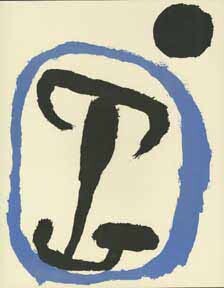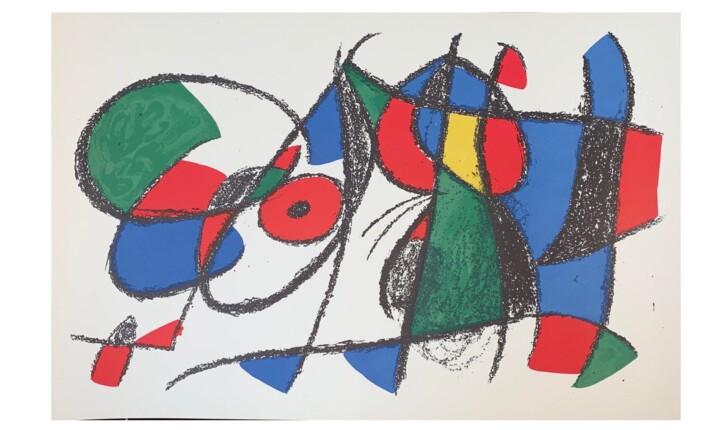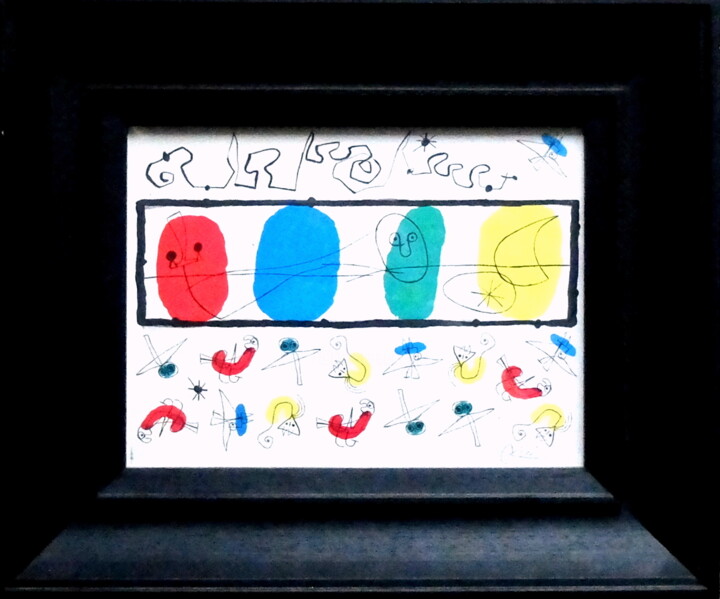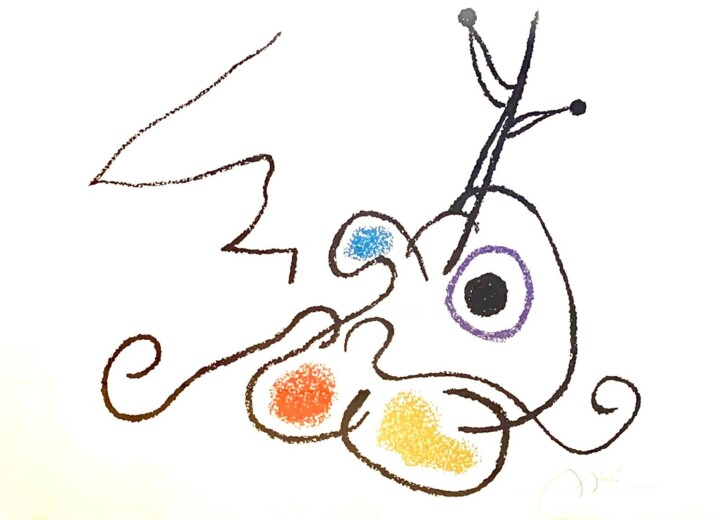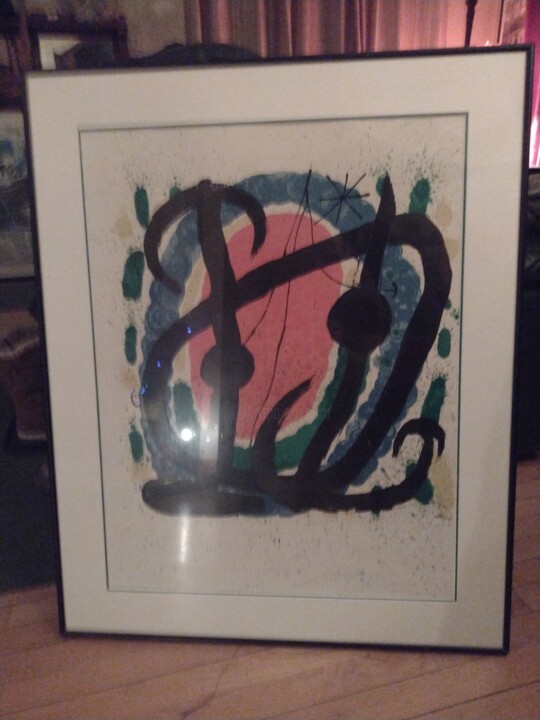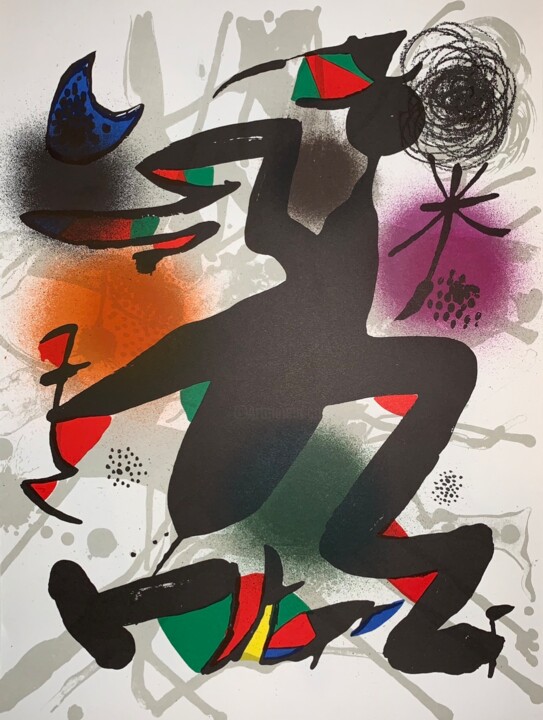Joan Miró was a visionary artist whose work defied traditional boundaries, blending elements of surrealism and abstraction to create a distinctive visual language. His art is characterized by a playful yet profound exploration of shapes, colors, and symbols, often imbued with a sense of childlike wonder and spontaneity.
From Barcelona to Surrealist Icon
Joan Miró i Ferrà, born on April 20, 1893, in Barcelona, Spain, emerged as a pivotal figure in 20th-century art, renowned for his bold exploration of surrealism and abstraction. His artistic journey began with a profound affinity for art, leading him to enroll at the School of Industrial and Fine Arts in Barcelona. Initially inspired by Catalan folk art and the vibrant colors of Fauvism, Miró swiftly transitioned towards surrealism, drawn to its liberation of the subconscious mind.
Miró's career unfolded over decades of relentless experimentation and innovation. His formative years in Paris during the 1920s proved transformative, as he engaged closely with luminaries such as Pablo Picasso and André Masson, absorbing their avant-garde influences while shaping his distinct artistic identity. Despite his international acclaim, Miró remained deeply connected to his Catalan roots, which imbued his work with a sense of cultural identity and resilience.
The tumultuous events of the Spanish Civil War profoundly impacted Miró's artistic perspective, prompting a poignant reflection on the human condition and the role of art in times of crisis. His paintings from this period resonate with symbolic imagery and a heightened emotional intensity, reflecting his commitment to capturing the essence of human experience amidst adversity.
Throughout his illustrious career, Miró continually pushed artistic boundaries, evolving towards a style characterized by whimsical biomorphic forms, vibrant colors, and symbolic abstraction. His iconic works, such as "The Tilled Field" and "The Birth of the World," stand as testament to his mastery of color and form, inviting viewers into a surreal realm where reality and imagination intertwine seamlessly.
Surrealism Unveiled
Joan Miró stands as a seminal figure bridging surrealism and abstract art, celebrated for his visionary exploration of the subconscious mind and boundless creativity. His artistic style is a testament to his innovative spirit, characterized by a rich interplay of biomorphic forms, geometric abstraction, and a vibrant, dynamic color palette that mesmerizes the eye and sparks the imagination. Miró's canvases serve as immersive landscapes where dream and reality coalesce, inviting viewers to embark on profound journeys of interpretation and introspection.
Miró's thematic breadth is as expansive as his artistic techniques. From celestial bodies suspended in cosmic harmony to whimsical creatures that defy earthly logic, his subjects evoke a sense of wonder and intrigue. Deeply rooted in his Catalan heritage, Miró also incorporates symbolic representations of cultural identity, infusing everyday objects with layers of mystery and meaning. Each brushstroke and composition reveals his mastery in transforming the ordinary into the extraordinary, challenging viewers to reconsider their perceptions of art and reality.
Throughout his career, Miró's work evolved alongside tumultuous historical events, from his formative years in 1920s Paris amidst avant-garde movements to the profound impact of the Spanish Civil War on his artistic sensibilities. His paintings from this period are marked by a poignant exploration of human suffering and resilience, expressed through symbolic imagery and emotional intensity.
Masterpieces of Surrealist Vision
Joan Miró's artistic legacy is epitomized by a series of iconic masterpieces that transcend conventional artistic boundaries, each a testament to his mastery of color, form, and symbolism. "The Tilled Field" (1923-1924) stands as a quintessential example of Miró's early surrealist explorations, where vibrant hues and abstract shapes converge to evoke a dreamlike landscape teeming with poetic resonance. This painting, with its fragmented forms and organic compositions, invites viewers to delve into Miró's subconscious world, where the boundaries between reality and fantasy blur.
In "The Birth of the World" (1925), Miró's artistic vision reaches its zenith as he distills cosmic elements into a mesmerizing tableau of primal creation. Here, celestial bodies and mystical symbols coalesce in a symphony of bold colors and lyrical brushstrokes, capturing the essence of genesis and the primordial forces that shape existence. This seminal work not only showcases Miró's technical virtuosity but also his profound philosophical inquiry into the origins of life and the universe.
"Woman and Bird in the Night" (1945) represents a pivotal moment in Miró's career, where he synthesizes surrealism with a deeply personal symbolism. The composition, characterized by stark contrasts and enigmatic forms, exudes a haunting beauty that speaks to themes of mystery and introspection. Miró's use of simplified, evocative imagery—such as the recurring motif of the bird—imbues the painting with a sense of timeless symbolism and emotional depth.
Finally, "The Flight of the Dragonfly in Front of the Sun" (1968) exemplifies Miró's late-period exploration of celestial themes and poetic abstraction. Here, the delicate yet powerful presence of the dragonfly, set against a radiant sun-like backdrop, symbolizes the ephemeral beauty of life and the transcendence of earthly constraints. Miró's expressive use of color and form evokes a sense of serenity and wonder, inviting viewers to contemplate the interconnectedness of nature and the cosmos.
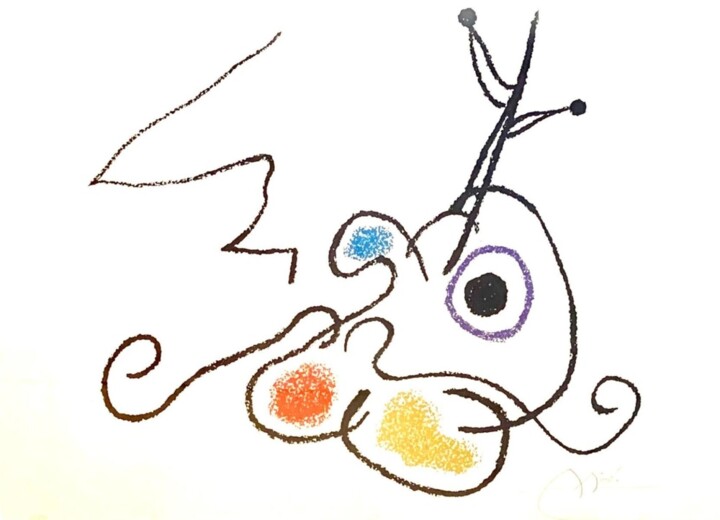 UBU AUX BALÉARES (1971) Printmaking by Joan Miró
UBU AUX BALÉARES (1971) Printmaking by Joan Miró
Exploring Joan Miró's Artwork
The work "UBU AUX BALÉARES" (1971) is a color lithograph created by the renowned Spanish artist Joan Miró. This piece is hand-signed and numbered in a limited edition, making it a valuable example of his graphic production.
The image depicts an abstract composition, typical of Miró's style, featuring sinuous lines and vibrant colors. At the center of the composition are curvilinear shapes and colored dots that suggest an anthropomorphic or fantastical figure, evoking the playful and surreal approach of the artist. The primary colors used are yellow, orange, blue, and purple, distributed in an apparently random yet harmonious way, creating a dynamic and lively visual effect.
The work is part of the series "Ubu aux Baléares," which recounts the adventures of Ubu, the protagonist of Alfred Jarry's play "Ubu Roi." Ubu is a grotesque and absurd character, and Miró captures this essence through the use of forms and colors that challenge logic and traditional representation. The serpentine lines and points of color impart a sense of movement and vitality, reflecting the chaotic and irreverent energy of Ubu.
Joan Miró is known for his distinctive style that combines elements of surrealism with a unique visual language comprised of symbols, abstract forms, and bold colors. In the 1970s, the period when this lithograph was created, Miró had already established his international fame and was exploring new techniques and expressive modes. The works from this period often reflect a greater creative freedom and an interest in experimentation, both in materials and forms.
Miró always sought to transcend the boundaries of traditional representation, creating a visual world filled with dreams and imagination. His works are characterized by a symbolic language rich in organic shapes, sinuous lines, and primary colors. In this context, "UBU AUX BALÉARES" fits perfectly into the corpus of his works, representing an example of his continual exploration of the absurd and the surreal.
In summary, "UBU AUX BALÉARES" is a work that embodies Joan Miró's playful and innovative spirit, connecting his distinctive style to the theatrical narrative of Ubu and adding an important chapter to the artistic journey of the Catalan artist.
Joan Miró's Enduring Influence on Contemporary Art
Joan Miró's legacy as a pioneering figure in modern art extends far beyond his own lifetime, shaping the trajectory of countless artists who have drawn inspiration from his innovative approach and profound artistic vision. Miró's exploration of abstraction, surrealism, and the subconscious mind continues to resonate deeply with contemporary artists, influencing their artistic practices in diverse and compelling ways.
Miró's impact on abstraction is particularly profound. His bold use of geometric forms, biomorphic shapes, and dynamic color schemes challenged traditional notions of representation, encouraging artists to experiment with new forms of visual expression. Contemporary abstract artists, such as Gerhard Richter and Julie Mehretu, cite Miró's fearless exploration of form and color as a pivotal influence in their own abstract compositions. Richter, known for his layered and textured canvases that blur the boundaries between representation and abstraction, acknowledges Miró's influence in his dynamic approach to painting. Similarly, Mehretu's intricate and expansive canvases, which explore themes of urbanism and globalization through abstract forms and gestural marks, reflect Miró's legacy of pushing the boundaries of artistic expression.
In the realm of surrealism, Miró's ability to evoke dreamlike landscapes and fantastical imagery has left an indelible mark on contemporary artists exploring similar themes. Artists like Salvador Dalí and Yayoi Kusama have drawn inspiration from Miró's playful yet profound engagement with the subconscious. Dalí, with his surrealistic melting clocks and eccentric symbolism, shares Miró's fascination with the dream world and the irrational. Kusama, known for her immersive installations and repetitive patterns, echoes Miró's interest in creating environments that transcend the ordinary and transport viewers into realms of fantasy and introspection.
Furthermore, Miró's exploration of the subconscious mind continues to resonate with contemporary artists who seek to probe the depths of human consciousness and emotion through their work. Artists such as Louise Bourgeois and Anish Kapoor explore psychological and existential themes in their sculptures and installations, echoing Miró's introspective approach to art-making. Bourgeois, with her emotionally charged sculptures that delve into themes of memory and trauma, shares Miró's interest in the psychological dimensions of art. Kapoor, known for his monumental sculptures that distort space and perception, reflects Miró's interest in creating art that challenges viewers' perceptions and invites contemplation.
Joan Miró's enduring influence on contemporary art is a testament to his status as a visionary whose legacy transcends time and geography. His ability to merge technical innovation with profound philosophical inquiry continues to inspire artists to push the boundaries of artistic expression and engage in a dialogue about the nature of reality, imagination, and the human experience. As artists continue to draw from Miró's rich visual vocabulary and fearless experimentation, his legacy as a transformative force in modern art remains vibrant and influential in shaping the future of artistic innovation.
Fascinating Anecdotes About Joan Miró: The Surrealist Visionary
1. Miró's Rural Roots and a Life-Altering Illness
Before Joan Miró became an acclaimed artist, he faced significant challenges. Born in Barcelona, he spent much of his youth in the countryside, which deeply influenced his love for organic forms and nature. After a severe illness in his early twenties, Miró decided to fully commit to art, leaving behind his business studies and immersing himself in painting. This pivotal moment marked the beginning of his illustrious career.
2. The Humble Beginnings in Paris
When Miró first moved to Paris in the 1920s, he lived in near-poverty in a tiny studio. Despite his financial struggles, he immersed himself in the vibrant artistic community, forging friendships with influential artists like Pablo Picasso and André Breton. These interactions significantly influenced his work, helping him to develop his unique surrealist style.
3. The Influence of Dreams
Miró often used dreams as inspiration for his work. He kept a dream journal and would frequently incorporate the surreal and fantastical elements from his dreams into his paintings. This practice helped him to create the dreamlike, imaginative quality that defines much of his art. His famous work "The Harlequin's Carnival" is said to have been inspired by his vivid dreams.
4. The Breakthrough Painting
One of Miró's breakthrough paintings, "The Farm," was a detailed depiction of his family’s country home in Mont-roig. This painting was bought by the famous writer Ernest Hemingway, who was a great admirer of Miró's work. Hemingway called it "a snapshot of a whole country," and it marked the beginning of Miró's international recognition.
5. The Playful Trickster
Miró was known for his playful and rebellious spirit. He once created a fake animal language, complete with its own alphabet, which he used in his paintings and sculptures. This playful approach to art helped him to challenge traditional artistic conventions and create his own unique visual language.
6. The Paris Wall Murals
During the German occupation of Paris in World War II, Miró fled to Spain but returned to Paris after the war. In a significant project, he was commissioned to create two large ceramic murals for the UNESCO building in Paris, which he completed in 1958. These murals, "The Wall of the Moon" and "The Wall of the Sun," are considered some of his most significant public works, symbolizing peace and creativity.
7. The Endless Curiosity
Miró’s insatiable curiosity and desire for experimentation never waned. Even in his later years, he was constantly exploring new materials and techniques, such as working with ceramics, sculpture, and printmaking. His relentless drive for innovation ensured that his work remained fresh and relevant throughout his life.
Joan Miró's legacy is one of artistic daring and imaginative exploration. Through his surrealistic visions and abstract compositions, he challenged the norms of his time and continues to inspire admiration and contemplation today. His ability to merge the playful with the profound has left an indelible mark on the world of modern art, making him a timeless icon whose work resonates across cultures and generations.


 Selena Mattei
Selena Mattei

